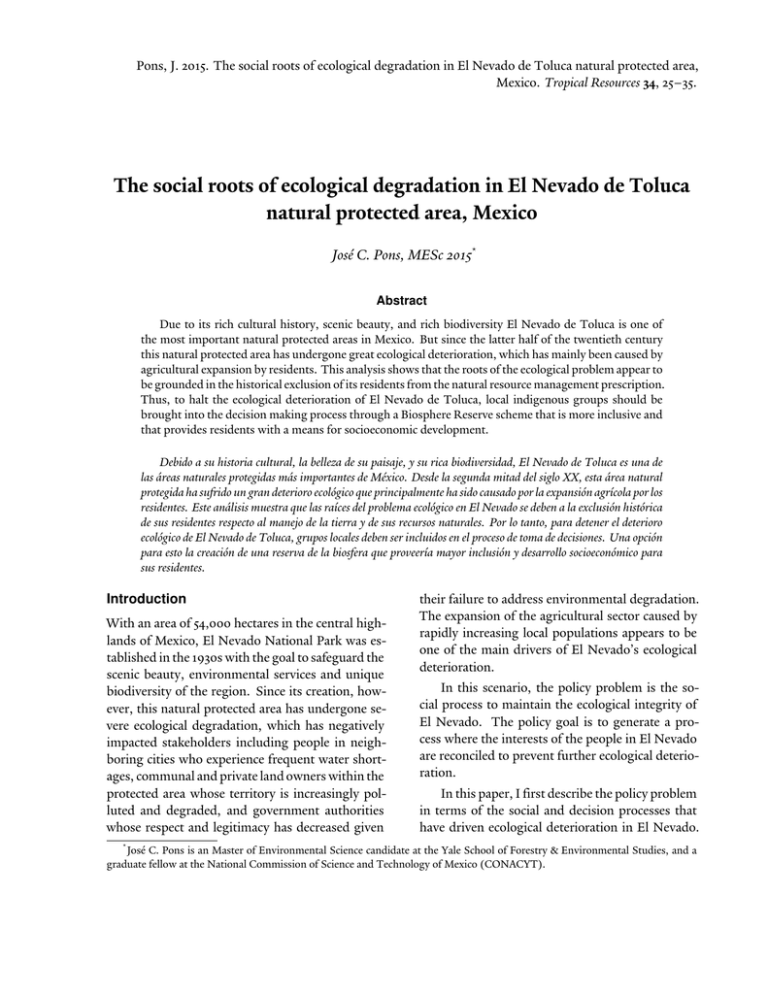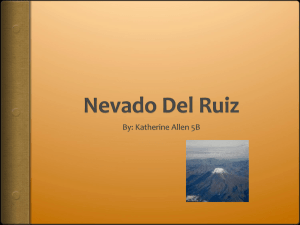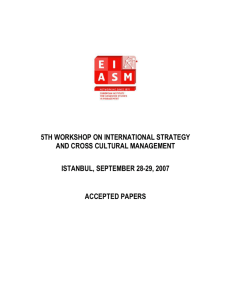Document 11492921
advertisement

Pons, J. 2015. The social roots of ecological degradation in El Nevado de Toluca natural protected area, Mexico. Tropical Resources 34, 25–35. The social roots of ecological degradation in El Nevado de Toluca natural protected area, Mexico José C. Pons, MESc 2015* Abstract Due to its rich cultural history, scenic beauty, and rich biodiversity El Nevado de Toluca is one of the most important natural protected areas in Mexico. But since the latter half of the twentieth century this natural protected area has undergone great ecological deterioration, which has mainly been caused by agricultural expansion by residents. This analysis shows that the roots of the ecological problem appear to be grounded in the historical exclusion of its residents from the natural resource management prescription. Thus, to halt the ecological deterioration of El Nevado de Toluca, local indigenous groups should be brought into the decision making process through a Biosphere Reserve scheme that is more inclusive and that provides residents with a means for socioeconomic development. Debido a su historia cultural, la belleza de su paisaje, y su rica biodiversidad, El Nevado de Toluca es una de las áreas naturales protegidas más importantes de México. Desde la segunda mitad del siglo XX, esta área natural protegida ha sufrido un gran deterioro ecológico que principalmente ha sido causado por la expansión agrícola por los residentes. Este análisis muestra que las raíces del problema ecológico en El Nevado se deben a la exclusión histórica de sus residentes respecto al manejo de la tierra y de sus recursos naturales. Por lo tanto, para detener el deterioro ecológico de El Nevado de Toluca, grupos locales deben ser incluidos en el proceso de toma de decisiones. Una opción para esto la creación de una reserva de la biosfera que proveería mayor inclusión y desarrollo socioeconómico para sus residentes. Introduction With an area of 54,000 hectares in the central highlands of Mexico, El Nevado National Park was established in the 1930s with the goal to safeguard the scenic beauty, environmental services and unique biodiversity of the region. Since its creation, however, this natural protected area has undergone severe ecological degradation, which has negatively impacted stakeholders including people in neighboring cities who experience frequent water shortages, communal and private land owners within the protected area whose territory is increasingly polluted and degraded, and government authorities whose respect and legitimacy has decreased given * their failure to address environmental degradation. The expansion of the agricultural sector caused by rapidly increasing local populations appears to be one of the main drivers of El Nevado’s ecological deterioration. In this scenario, the policy problem is the social process to maintain the ecological integrity of El Nevado. The policy goal is to generate a process where the interests of the people in El Nevado are reconciled to prevent further ecological deterioration. In this paper, I first describe the policy problem in terms of the social and decision processes that have driven ecological deterioration in El Nevado. José C. Pons is an Master of Environmental Science candidate at the Yale School of Forestry & Environmental Studies, and a graduate fellow at the National Commission of Science and Technology of Mexico (CONACYT). Conditions of El Nevado de Toluca Then I analyze the main trends and factors that have led to the problem, and discuss what is likely to happen if these factors are not addressed in the short term. In the last section, I make some recommendations to strengthen the ability of actors to cope with future challenges in natural resource policy and management in El Nevado. Standpoint My standpoint with respect to the policy problem is as an advocate and participant-observer. I was born and raised in Toluca, in the State of Mexico, a city only 20 km north of El Nevado. From schoolorganized events to friends and family field trips, I have been a regular visitor to El Nevado. This place has been very influential in both my heuristic development as a natural and social scientist, and my keen interest in resource management. Beyond a source of motivation, El Nevado is also the landmark of my home town, the main water provider of the region, an important carbon sink, and a historical site that has traditionally been treasured for its spiritual values. As my grandmother pointed out to me, “El Nevado is the grandfather of the inhabitants of the State of Mexico”. The main source of information used for this study is direct observation acquired since May 2011, when I became formally acquainted and involved in the policy problem in El Nevado. During this time, my interest in addressing the policy problem of El Nevado led me to form the non-governmental organization Sumando Personas (Bringing People Together). As a result, I have interacted with other stakeholders and I favor the ecological integrity of El Nevado over its degradation in part because I do not depend on its natural resources for subsistence. Problem Provisional statement El Nevado is one of the most important natural protected areas in Mexico. At over 4,400 meters elevation, it is the fourth highest mountain in Mexico and home to the two highest lakes in the American 26 Volume 34, 2015 continent. El Nevado is home to 1,127 species, including 235 animals and 768 plants, many of which are endemic to the region (Ceballos 2011). Although the landscape is dominated by perennial forests, most of them pine trees, El Nevado also hosts grasslands and even tundra ecosystems near the top of the mountain. Since pre-Columbian times, El Nevado was visited and venerated for the many environmental and spiritual services it provides. The Aztecs referred to El Nevado as Xinantecatl, or ‘nine springs’. For the Matlatzinca people, another pre-Columbian ethnic group, El Nevado was named Nro’maani Nechhútata, the ‘house of the god of water’. Today, the basins that drain from El Nevado provide 30% of the water used by the city of Toluca, the closest neighboring city, and 14% of the water used in the metropolitan area of Mexico City, where more than 20 million people reside (Gobierno del Estado de Mexico 2011). The main problem in El Nevado is the ecological deterioration of the natural ecosystems caused by local residents through unregulated economic activities. This deterioration has been documented through the decrease in native land-cover, where only 17,000 ha of natural vegetation of the original 54,000 ha remains—a loss of almost 70% (Maass et al. 2006, Fig. 1). Furthermore, 60% of the remaining vegetation is now affected by invasive organisms and disease (Rios & Gutiérrez 2008, Vega 2008). The remarkable vegetation loss of the park appears to be caused by an array of illegal activities, including livestock grazing and the use of fire to enhance the agricultural output. The loss of vegetation has consequently led to other forms of environmental degradation. According to Sanchez et al. (1990) 35–40% of the park area experiences severe forms of soil erosion, which in turn has affected water provision services in Toluca and the Valley of Mexico. Furthermore, landslides during the rainy seasons have resulted in a number of human deaths (Ceballos 2011). © The Author. Tropical Resources © Yale Tropical Resources Institute Pons, J.C. Fig. 1. Map of El Nevado de Toluca’s vegetation cover in 2000 (from Maass et al. 2006). Context The problem in El Nevado can be clarified in terms of the seven functions that characterize decision processes: intelligence, promotion, prescription, invocation, application, termination, and appraisal (Clark et al. 2000, Lasswell & McDougal 1992). These processes illustrate the dynamic nature of the policy process. 1. Intelligence The intelligence function refers to gathering, processing, and dissemination of information. Despite the high levels of environmental degradation in El Nevado and its’ importance as a provider of environmental services, there has been little information generated on the main drivers of ecological degradation. Until 1998, the sole providers of information were academics from the Autonomous University of the State of Mexico (UAEM) and National Autonomous University of Mexico (UNAM), and they remain the main sources of data. Another source are the federal, state, and local governments, whose researchers were also among the first to produce figures on soil erosion and water infiltration (Ceballos 2011). It is important to note that local residents of El Nevado are not formally recognized as part of the intelligence function: They are not part of the decision-making process, nor do they provide feedback or information regarding ecological deterioration. If intelligence is not being collected from or by the people who are directly responsible for generating the problem, it is unlikely that government agencies can generate management prescriptions that work both for people and the environment. 2. Promotion The promotion function refers to the way in which proscriptions are formulated and promoted. The federal government of Mexico is the main promoter Tropical Resources Bulletin 27 Conditions of El Nevado de Toluca of the official course of action within El Nevado: the legal status of the area was assigned through an executive mandate in 1936. The status of El Nevado as a national park provides a set of regulations to prevent the environmental degradation of the place. The federal government seeks power and respect in the form of votes and public acceptance by maintaining the scenic beauty and environmental services that El Nevado provides to the nearby population of over 20 million people. In this light, the interest of the federal government to promote El Nevado’s ecological integrity can be seen as a strategy to maintain its own institutional interests. Aside from official courses of action, there are other groups promoting non-official courses of action, among the most important of these are local communities within the national park. One of the incentives for residents to promote the ecological preservation of El Nevado is the income and wellbeing they acquire from tourism. In the winter season (December to March), approximately 8,000 people visit the park daily, spending money on park entrance fees and local goods and services (Ceballos 2011). However, local residents also promote other courses of action with respect to the problem that might conflict with the preservation of El Nevado. Residents often promote agricultural activities within the park, something that despite being illegal is widely practiced. Examples of these activities include the production of potato, corn, and livestock. The expansion of the agricultural frontier into the park is one of the main causes of the loss of native cover and vegetation. The problem is exacerbated because farmers use fire to enhance the productivity of the land. Fires frequently get out of control and are the primary driver of loss of perennial forest cover in the park (Ceballos 2011). In this scenario, the interests of local residents for agriculture conflict with those of the authorities who are responsible for maintaining the ecological integrity of the park. 28 Volume 34, 2015 3. Prescription The prescription function refers to the formulation and enactment of polices and guidelines for action (Clark 2002). As discussed above, more than one course of action is promoted or incentivized in El Nevado. This situation is partly explained by the fact that the official prescription of the protected area does not successfully reconcile the interests of all actors towards a common goal. The prescription to maintain the ecological integrity of El Nevado is given the by its legal statue as national park. This status was awarded in 1936 by the federal government without any scientific or technical justifications. A detailed map of the area comprising the park was published 50 years after the reserve was established. This situation has led to territorial conflicts between the main actors: the ejidos (communally-owned lands), private landowners, and public authorities. Some of these conflicts have not been resolved to this day, resulting in an array of unregulated activities in the park because the activities of local settlers are neither allowed nor sanctioned. 4. Invocation The invocation function refers to the rules put into practice to enforce prescriptions. In the case of El Nevado, the authorities have not enforced the official designation of a national park because the prescription is based on a limited perspective, and its enforcement would require highly coercive strategies. As noted, neither human settlements nor the consumptive use of resources are allowed in national parks according to Mexican law. The enforcement of this mandate would require the evacuation of more than ten thousand people, the majority indigenous groups. Although beneficial for the ecological intgrity of El Nevado, the invocation of this prescription would require extraordinary military efforts by the authorities, and would likely involve human rights violations. Furthermore, other actors involved, including residents or tourists, do not obey rules for two main © The Author. Tropical Resources © Yale Tropical Resources Institute Pons, J.C. reasons. First, proscriptions are often unclear or inexistent. Although the legal definition, and basic attributes of National Parks are specified in various bodies of Mexican laws such as the constitution and LGEEPA (General Law on Ecological Equilibrium and Environmental Protection), a clear and comprehensive plan to organize the actions of people involved in El Nevado not been defined to this date. Second, El Nevado lacks, and has never had, a management plan. 5 & 6. Application and termination The application and termination functions refer to the mechanisms by which the main actors in El Nevado can resolve disagreements or disputes, and can stop or change the rules. These can be via official or non-official arenas. In Mexico, official conflict-resolution mechanisms within natural protected areas are attributed and specified in each area’s management plan. However, given the lack of such a plan for El Nevado, actors resort to other arenas to resolve conflicts. One of the most important arenas is the federal courts, whereby local communities, academics, or other actors can have recourse against the federal government for establishing a legal scheme that affects their values and interests. However, one of the main problems with the courts is that substantial legal skills, time, and wealth are needed to pursue a case—resources which the local communities in El Nevado do not have: these communities have some of the highest rates of illiteracy and economic marginalization in Mexico. Other venues to voice disagreements and change rules exist through non-official channels, and they depend on the actors involved. Academics, for instance, have expressed their discontent with the inefficiency of the national park scheme through academic publications and public hearings, such as conferences or lectures. Local communities have expressed their opposition through public protests and by breaking the rules imposed on them. The views of visitors and other citizens concerned with El Nevado have been mainly expressed through social media, an outlet of social discontent whose reach and relevance has increased substantially in the last decade. The importance of application and termination functions is that they serve as conflict-resolution mechanisms. They are essential to maintain a working system in the long-term, as the interests of the people are constantly changing and shaping the policy in place. The relation between official and non-official arenas is such that they can be complementary, but both require high levels of economic and political resources to be implemented. Official spheres such as federal or estate courts should be in theory open to all stakeholders, however, in practice they often demand perhaps more time and resources than unofficial channels. With the rise of the media, more, and more efficient, unofficial channels are growing in importance and popularity. Facebook and Twitter are now common ground for debate and social participation. 7. Appraisal The appraisal function refers to the continuous assessments made to evaluate the successes or failures of the program in place. Appraisal is also important to determine accountability for actions. In a similar fashion to the application and termination functions, appraisal is often specified in the management plan, which is non-existent in El Nevado. Thus, El Nevado currently lacks appraisal mechanisms to evaluate its policies and outcomes. Redefining the policy problem Although the main problem of environmental degradation was defined initially as simply the product of the anthropogenic impacts in the area, from this analysis it is seen that the problem has been fundamentally propagated by the exclusion of local residents from the decision-making process. Because the legal status of the area prevents local residents from undertaking essentially any sanctioned economic endeavor, they resort to agriculTropical Resources Bulletin 29 Conditions of El Nevado de Toluca Fig. 2. North face of El Nevado de Toluca, a national protected area in México. Credit: José Pons. tural production as a subsistence strategy. The status of the area as a national park is inadequate because local residents were (and still are) excluded from the intelligence decision process. As noted, this prescription has caused fundamental problems with other decision functions, such as invocation, termination, and appraisal. Analysis The exclusive history of El Nevado National Park The illegal exploitation of natural resources in Mexico peaked in 1934, as a result of the agrarian reform brought by the Mexican revolution in 1910. This situation was recognized and addressed by the authorities at the time, who responded by establishing a network of natural protected areas to prevent the further exhaustion of natural resources. The protected areas were established under the legal status of National Parks. Most of these areas, however, were established within a few years, and without social consensus or technical justifications, as in the case of the El Nevado (Fig. 2). The one-paragraph decree authorized by the ruling president of Mexico in 1936, Lazaro Cardenas, justifies the park creation as an action to protect the forest cover and the hydrological services it provided to the cities nearby. The decree, however, did not specify the park’s bound30 Volume 34, 2015 aries, zoning, rules or regulations, nor did it indicate the methodology or operation to manage the new protected area. As in most other national parks in Mexico, there were (and still are) human settlements located inside the perimeter of El Nevado prior to its establishment. Despite this, the existence of human settlements was ignored, and the effects that the park foundation would have on the people and their lands were not evaluated. Not surprisingly, the poor oversight of the executive government to assess the repercussions of the park establishment on land tenure hindered conservation efforts. The change in land jurisdiction created a series of adverse effects, including the dilution of the original tenant rights, and as a by-product, private land became vulnerable to invasion and colonization by foreigners. Overnight, the establishment of the national park provided free open access to common resources. This situation translated into deforestation, overgrazing, pollution and other important drivers of ecological deterioration that are still prevalent in the park. This historical context is important to explain the environmental degradation in El Nevado today, as the modification of the legal status of the land caused unprecedented uncertainty with respect to property rights and natural resource use. © The Author. Tropical Resources © Yale Tropical Resources Institute Pons, J.C. mental degradation if not well-managed. 10000 TOTAL 8000 Population Size Since the park’s establishment, there has been an ongoing feud between people who held land titles prior to the park establishment, and the people who have occupied such lands after the park was established. Paradoxically, according to Mexican law, both owners and settlers should have been compensated and removed eighty years ago. The conflict over land ownership has historically hindered the capacity of the authorities and other stakeholders to agree on how natural resources in El Nevado should be managed. One of the clearest outcomes is that, as noted, the park lacks a management plan. Without a clear system of land organization and resource management, there is an incentive to maximize the resource accumulation and exploitation by users, which explains much of the environmental degradation that occurs in the park in the present. 6000 4000 Population growth in El Nevado 1990–2010 Population growth is an important factor to explain environmental degradation in El Nevado because it is closely related the expansion of agriculture and livestock production, the main drivers of land-cover change. According to the National Institute of Statistics and Geography in Mexico (INEGI 1990, INEGI 2010), as of 2010 there were 22 communities (in seven municipalities) in El Nevado with a total population of 10,255 people. Many of these communities were founded in the 1930s, the time when the park was founded. Moreover, the population is increasing at a remarkable rate, almost doubling in the last two decades (Fig. 3). The average growth rate was 147% (1990–2000) and 117% (2000–2010). These growth trends reflect the increasing human pressure on the natural resource base of El Nevado. Population increase comes with a rise in the demand for subsistence resources, which accordingly translates into the expansion of arable lands, grazing livestock, and water extraction. Thus, population growth causes a greater dependence on the landscape, causing greater environ- COMMUNITIES 2000 0 1990 2000 2010 Year Fig. 3. Population growth by community in El Nevado (1990–2010). Grey lines indicate the population of each community in 1990, 2000, and 2010. The black line indicates the total population size, summing over all communities. Socioeconomic factors The precarious socioeconomic condition of the local communities in El Nevado is an important factor to account for exclusion, and increasing population growth. The National Census of 2010 presents the following figures. There are 1,299 households registered in El Nevado. Of these, only 577 (less Tropical Resources Bulletin 31 Conditions of El Nevado de Toluca than 50%) have access to electricity, water provision and drainage. Furthermore, more than 30% of the population of 15 years of age or older did not finish primary education, none of the households in El Nevado have internet access, and the average illiteracy rate for each community is 17%, which stands in contrast to the national average of 6.9%. The National Council of Population rated 19 of the 22 El Nevado communities with ‘high’ levels of marginalization and the remaining 3 as ‘very high’ (INEGI 2010), based on seven variables: illiteracy, drainage, electricity, dirt floors, clean water provision, number of people per household, and income. These assessments illustrate the precarious economic situations in which people in El Nevado live. Exclusion is clear from the fact that residents do not benefit socially or economically from the decision process. Residents are unable to challenge this situation through official legal channels, as they lack the financial resources to do so. Further, the high illiteracy rates and poor educational background likely drive the high population growth of the area. Family planning is hindered by a lack of information and means available, and religious institutions have a profound influence on the value systems of the people. Poor socioeconomic conditions further contribute to the non-regulated expansion of agriculture. Future trends If local residents are not provided with a clear and plausible alternative to improve their socioeconomic conditions, population growth and exclusion from the decision process is likely to continue. This situation would consequently foster the continuous expansion of non-regulated productive activities, resulting in further loss of native vegetation, soil erosion, and water provision services. In summary, the environmental degradation of El Nevado is likely to continue because the interests of the local residents are not included in the policy process. 32 Volume 34, 2015 Recommendations and evaluation In light of the previous description and analysis of the policy problem in El Nevado, two prescriptions are proposed and evaluated, and one selection is justified. 1. The original plan: compensation and relocation of residents One option to resolve the policy problem in El Nevado is to complete the plans that were originally prescribed: to financially compensate and relocate all the residents within the protected area. By reducing the population size, this solution would lessen the main anthropogenic impacts that cause environmental degradation. This option would require wealth, diplomacy, and most likely military efforts to be deployed by the federal government, as well as an alternative site, most likely urban, to relocate the people. The financial compensations for the land expropriated could allow people to invest into other productive activities, bettering their current unfavorable socioeconomic condition. Evaluation of the original plan Major drawbacks of this first option are the financial cost of compensating and relocating local residents as well as their willingness to leave or sell their land. Therefore, the federal government might have to move from a diplomatic to a military strategy to ensure compliance. This change could easily end in the infringement of the human rights of residents, as well as the high political cost to the government authorities in charge of relocation. In the case where the incumbent government is willing to take the political risk to use coercion to relocate the residents of El Nevado, the complexity comprised in the legal situation would present another significant challenge. The lack of clarity of land tenure means that it would be difficult for the authorities to know whom and how much to pay. Furthermore, despite compensation, residents’ socioeconomic condition is unlikely to improve. The high illiteracy rates and low levels of education © The Author. Tropical Resources © Yale Tropical Resources Institute Pons, J.C. combined with relocation might prevent residents from engaging in other productive activities. Relocation could ultimately have pernicious effects for the socioeconomic welfare of those who move. 2. A new plan: inclusion of all stakeholders A second prescription to address the policy problem in El Nevado is the creation and promotion of a new management plan, one that is based on the interests of the majority of the stakeholders. This plan should listen to local communities and include them in the decision process. An important element of the new management plan would be to strictly regulate the number of people and activities undertaken in the park. A good alternative management scheme provided by the General Law on Ecological Equilibrium and Environmental Protection (LGEEPA) is that of a Biosphere Reserve. These designations allow human settlements and the consumptive use of natural resources within the protected area, thus aiding the socioeconomic development of El Nevado. However, biosphere reserves need detailed management plans and effective regulations to control and guide the anthropogenic impact on the protected areas. Therefore, preconditions of the success of such a reserve in El Nevado are (i) that local residents are included into the intelligence and promotion process, and (ii) ensuring that all land tenure conflicts are resolved by offical means. Evaluation of the new plan The re-categorization of El Nevado as a Biosphere Reserve would also come with challenges. One of the most important is again, the conflict over land tenure. Without clear territorial jurisdiction, the zoning and organization of the protected area is a complex endeavor. Re-classification in itself will not solve the issues—the highest risk is that, like the current scenario, the new biosphere reserve scheme will lack a management plan, fostering an array of illegal and unregulated activities that would con- tinue the environmental degradation of El Nevado. Selection From the two alternatives, I conclude that the redefinition of El Nevado as a Biosphere Reserve is the best option. From my analysis, the problem of El Nevado is rooted in the exclusion and marginalization of local people and is unlikely to be resolved through further exclusion and impoverishment. Assuming that the legal conflicts over land tenure can be resolved, and local inhabitants are included into the decision process, the biosphere reserve can provide the flexibility necessary to accommodate the common interests and protect the ecological integrity of El Nevado. Thus, the following key actions are fundamental to enhance success of a biosphere reserve in El Nevado and should form central components of the management plan, effectively administered and enforced by the government: 1. Inclusion of local residents into all functions of the decision process, including the early conceptualization and planning of the biosphere reserve. 2. Provide the financial and legal means to resolve conflicts over land tenure in El Nevado in the short-term. 3. Legal recognition of human settlements in the area, investment on infrastructure to provide basic services (electricity, drainage, potable water, and internet). 4. Zoning of core and buffer areas, with a detailed description of the activities allowed in each area, and clear delimitation of urban zones. 5. Design and implementation of an educational program to increase the educational level of the local residents, particular focus should be placed on illiteracy rates. Components on the cultural, historic, and environmental importance of El Nevado should also be included. Tropical Resources Bulletin 33 Conditions of El Nevado de Toluca 6. Payment for ecosystem services, where the main benefactors are the local residents. 7. Forest management plan, with the local residents as operators and benefactors. 8. Develop eco-tourism in the protected area, where the local residents are the main administrators and benefactors. 9. Detailed plans to monitor environmental conditions of the park should be created. Academia, government, and local residents should be part of the monitoring system. 10. Create a management council with representatives of all major actors involved, and provide a detailed agenda to discuss conflicts, disputes, and modification to the rules and regulations of the protected area. Conclusion For its cultural history and the environmental services it provides, El Nevado de Toluca is one of the most important natural protected areas in Mexico. El Nevado is currently undergoing great ecological deterioration, primarily exemplified by the loss of native land cover, soil erosion, and water provision services. The main cause of environmental degradation is the agricultural expansion of local residents, who resort to these activities as a means of subsistence. The legal status of El Nevado does not recognize human settlements or economic activities within its jurisdiction, and leaves the actions of local residents unregulated. In this light, the roots of the problem appear to be grounded in the historical exclusion of local residents from the natural resource management prescription, increasing population growth and unfavorable socioeconomic conditions. To resolve the policy problem in El Nevado requires the termination of the national park scheme and the establishment of a biosphere reserve. This legal status would provide the flexibility to include local residents into the decision process, provide a means for socioeconomic development, and preserve the ecological integrity of El Nevado1 . Acknowledgements Thanks to Simon Queenborough for his motivation and support to publish this piece. References Ceballos, G. 2011. Recategorización del Parque Nacional Nevado de Toluca. Estudio Técnico, Gobierno del Estado de México, Secretaría de Medio Ambiente. Clark, S.G., Willard, A.R. & Cromley, C.M. 2000. Foundations of Natural Resources Policy and Management. Yale University Press, New Haven, CT, USA. Clark, S.G. 2002. The Policy Process: A practical guide for natural resources professionals. Yale University Press, New Haven, CT, USA. Gobierno del Estado de Mexico. 2011. Propuesta de Recategorización y Edecreto del Parque Nacional Nevado de Toluca. Instituto Nacional de Estadística, Geografía e Informática Jimenez (INEGI). 2010. XII Censo General de Población y Vivienda. México. Instituto Nacional de Estadística, Geografía e Informática (INEGI). 1990. XI Censo General de Población y Vivienda. México. Lasswell, H.D. & Macdougal, M.S. 1992. Jurisprudence for a Free Society: Studies in law, science, and policy. New Haven Press, New Haven, CT, USA. Maass, S.F., Regil Garcia, H.H. & Ordoñez Díaz, J.A. 2006. Dinámica de perturbaciónrecuperación de las zonas forestales en el Parque Nacional Nevado de Toluca. Madera y Bosques 12, 17–28. 1 After this article was finalized, and before it was published, the federal government of Mexico changed the legal scheme of El Nevado de Toluca from a National Park category to an Area for the Protection of Flora and Fauna (APFF). As it legally recognizes the presence and socioeconomic needs of the human populations found in El Nevado, the APFF scheme provides a stronger, if not panacean, alternative to resolve the ecological degradation of this remarkable natural protected area. 34 Volume 34, 2015 © The Author. Tropical Resources © Yale Tropical Resources Institute Pons, J.C. Sánchez, A., Sánchez, A., Garcéda, M., Gustavo, G. & Sánchez, N. 1990. Apuntes para la historia forestal del Estado de México, México. Probosque. Editorial de Equipo Editor, SC Mexico. Rios, S.E. & Gutiérrez, R.G. 2008. Condiciones para la incorporación de proyectos ecoturísti- cos en el municipio de Jilotzingo. Páramo del Campo la Ciudad 15, 4–33. Vega, M.J. 2008. Crecimiento económico y deterioro ambiental de las localidades del Parque Nacional Nevado de Toluca. Páramo del Campo la Ciudad 15, 140–159. Tropical Resources Bulletin 35







